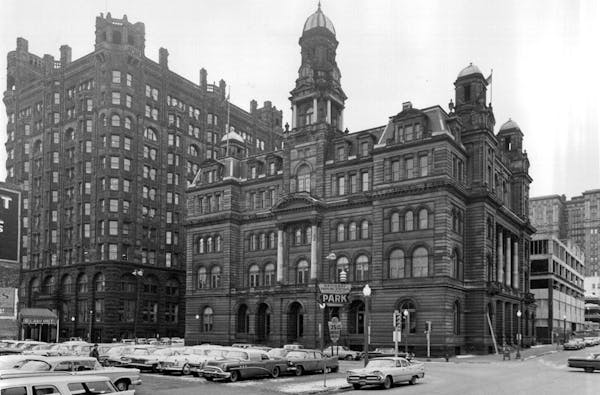The Minneapolis skyline is unique, isn't it?
Well, not exactly. Many of the buildings in our city have relatives in other cities — sometimes distant cousins, sometimes siblings, sometimes twins.
Take Cesar Pelli's magnificent Wells Fargo Center, for example. The building (90 S. 7th St.) is a slender, graceful, tapered tower, a marvelously proportioned, that rises 57 stories above the street. No one would say the building is a copy of 30 Rockefeller Center in New York City, but the Wells Fargo Center was likely inspired by the tapered Art Deco beauty that was built in 1933.
When Wells Fargo was completed in 1988, it made a statement: Midwestern cities can have Gotham-style glamour, too. Here is a look at the local landmarks that are and aren't uniquely ours:
Separated at birth
When it was completed in 1981, it was known as Pillsbury Center. Now under the banner of U.S. Bank Plaza, the building at 200 S. 6th St. has become a landmark, with its clean-looking double towers sheathed in travertine marble.
Its admirers might be surprised, however, to find a one-tower doppelgänger in Kansas City, Mo. Called City Center Square, it was designed by the same architecture firm (Skidmore, Owings & Merrill) that designed U.S. Bank Plaza. It was completed in 1977, so our building can't be said to be original. But with its two towers set at angles and joined by a glass atrium, it's definitely more visually appealing than its Kansas City twin.
A foreign relative
The Capella Tower (225 S. 6th St.) is known for the jaunty halo that sits atop the 56-story building. While that clever cap makes it stand out among the city's other skyscrapers, its similarity to the Westendstrasse 1 in Frankfurt, Germany, can't be overlooked.
Best of the bunch
In the 1950s and '60s, architects turned out scores of glass-and-steel towers. One classic is the Lever House in New York City, which was built in 1952. Another classic? Minneapolis' Canadian Pacific Plaza building (120 S. 6th St.). While not all postwar modernist designs can stand the test of time, Canadian Pacific Plaza has a lightness and restraint that keeps the 1960 building fresh and modern.
Twin City twins
It's bad enough to design a fortress like St. Paul's Town Square (445 Minnesota St.), but it takes real chutzpah to dust off the design and pass it off as City Center in Minneapolis (33 S. 6th St.). But that's what happened.
The two buildings aren't identical: There are minor variations in the facades. And City Center's 33 South Sixth is almost twice the height of Town Square's Bremer Tower, which gives Minneapolis bragging rights in the ugly derby. But it does make you wonder how many other cities are riddled with a similar design.
A defining structure
In the early 1970s, mirrored-glass buildings were the thing. The IDS Center could have been just another shiny box. But architect Philip Johnson created an alluring example of the genre by faceting the facade, which slimmed the tower's bulk and gave it directional dimension.
Since it was completed in 1972, it's been considered the "centerpiece" of the city skyline. And its overwhelming dominance certainly made our cityscape distinctive and set us apart from other Midwestern cities. But there's another building that makes Minneapolis.
There's only one Foshay
No other city has an enormous Egyptian obelisk with its financier's name on all four sides in big lights. It's possible that after it opened in 1929, other developers in other cities wanted a Foshay, a building inspired by the Washington Monument. But the stock market crash of '29 took care of that.
Once its 32 stories made it the tallest building in Minneapolis. Now it's a runt compared with the other skyscrapers, many of which are nearly twice its height.
In some ways, though, it'll always be our city landmark: the one building in the skyline that generations have looked at to know they're home.





